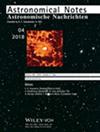可视双星 61 Cyg 的轨道
IF 1.1
4区 物理与天体物理
Q3 ASTRONOMY & ASTROPHYSICS
引用次数: 0
摘要
我们介绍了通过定位观测(包括高精度盖亚数据)以及对各组成部分的径向速度和径向加速度差异的测量所获得的可视双星61 Cyg各组成部分的轨道和质量估计值。由于这颗恒星的轨道周期大大超过了观测周期,利用径向速度和径向加速度可以减少在确定轨道元素和系统总质量方面的不确定性。本文章由计算机程序翻译,如有差异,请以英文原文为准。
Orbit of the visual binary star 61 Cyg
We present the orbit and the mass estimates for the components of the visual binary star 61 Cyg obtained with the positional observations, including the high-precision Gaia data, and the measurements of differences in the radial velocities and the radial accelerations of the components. Since the orbital period of this star significantly exceeds the period of observations, using the radial velocities and the radial accelerations allows us to reduce uncertainty in the determination of the orbital elements and the total mass of the system.
求助全文
通过发布文献求助,成功后即可免费获取论文全文。
去求助
来源期刊

Astronomische Nachrichten
地学天文-天文与天体物理
CiteScore
1.80
自引率
11.10%
发文量
57
审稿时长
4-8 weeks
期刊介绍:
Astronomische Nachrichten, founded in 1821 by H. C. Schumacher, is the oldest astronomical journal worldwide still being published. Famous astronomical discoveries and important papers on astronomy and astrophysics published in more than 300 volumes of the journal give an outstanding representation of the progress of astronomical research over the last 180 years. Today, Astronomical Notes/ Astronomische Nachrichten publishes articles in the field of observational and theoretical astrophysics and related topics in solar-system and solar physics. Additional, papers on astronomical instrumentation ground-based and space-based as well as papers about numerical astrophysical techniques and supercomputer modelling are covered. Papers can be completed by short video sequences in the electronic version. Astronomical Notes/ Astronomische Nachrichten also publishes special issues of meeting proceedings.
 求助内容:
求助内容: 应助结果提醒方式:
应助结果提醒方式:


